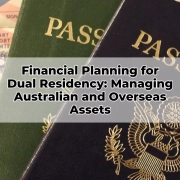What You Need to Know About Australian Life Cycle Funds
Table of Contents
ToggleLife cycle funds, also known as target-date funds, are a type of managed investment strategy designed to automatically adjust asset allocation as investors age. These funds are structured to balance growth and risk by shifting from aggressive investments in early years to more conservative ones closer to retirement. In the Australian financial landscape, life cycle funds are widely integrated into superannuation products, making them an essential consideration for retirement planning.
The Structure of Life Cycle Funds
Life cycle funds are typically structured to align with an investor’s expected retirement date. Younger investors are allocated a higher proportion of growth assets, such as equities, to maximise long-term returns. As they approach retirement, the allocation gradually transitions to defensive assets like bonds and cash to preserve capital. This automated approach reduces the need for active investment management, making it an appealing option for those seeking a hands-off strategy for their superannuation.
The Benefits of Life Cycle Funds
One of the primary advantages of life cycle funds is their simplicity. Investors do not need to rebalance their portfolio manually, as the fund automatically adjusts over time. This set-and-forget approach can be beneficial for individuals who lack the time or expertise to manage their investments actively. Additionally, life cycle funds help mitigate sequencing risk—the danger of experiencing market downturns just before retirement—by shifting to safer assets as retirement approaches.
The Risks and Limitations of Life Cycle Funds
While life cycle funds offer a structured investment pathway, they are not without risks. The automatic de-risking process may be overly conservative for some investors, potentially leading to lower returns in later years. Additionally, these funds do not consider individual financial circumstances, risk tolerance, or external investments. Investors should assess whether the default glide path aligns with their specific retirement goals.
How Life Cycle Funds Fit Within Superannuation
Many Australian superannuation funds offer life cycle investment options as a default setting for members who do not select their own investment strategy. This means that a significant portion of Australians is already invested in life cycle funds without actively choosing them. Understanding how these funds operate within superannuation can help individuals make informed decisions about whether to remain in the default option or opt
for a more customised investment approach.
Comparing Life Cycle Funds to Other Investment Strategies
Compared to other superannuation investment options, life cycle funds provide a more automated, long-term strategy. However, they differ from balanced funds, which maintain a static asset allocation, and from self-managed portfolios, where investors make active decisions about asset distribution. Understanding these differences can help individuals determine whether a life cycle fund aligns with their retirement planning
needs.
The Role of a Financial Adviser in Life Cycle Fund Selection
A Toowoomba Financial Adviser can provide personalised guidance on whether a life cycle fund is appropriate based on an individual’s financial goals, risk tolerance, and other investments. While these funds are designed for convenience, they may not suit every investor’s needs. Consulting a professional ensures that investment decisions align with long-term objectives rather than relying solely on default options.
Evaluating the Performance of Life Cycle Funds
Not all life cycle funds are created equal. Investors should compare fund performance, fees, and asset allocation strategies across different superannuation providers. Some funds may implement more aggressive de-risking strategies, while others maintain a higher equity exposure for longer. Reviewing historical performance and future projections can provide insight into how these funds align with retirement goals.
Fees and Costs Associated with Life Cycle Funds
Fees can significantly impact long-term investment returns, making it crucial to evaluate the cost structures of life cycle funds. Management fees, administration fees, and investment fees can vary between providers. Lower-cost options may yield better net returns over time, while higher-fee funds may provide additional features such as active management or personalised adjustments.
Customising Your Superannuation Strategy
While life cycle funds offer a default investment pathway, they are not the only option. Investors can tailor their superannuation strategy by selecting alternative asset allocations, engaging in Financial Planning Toowoomba, or seeking an Online Financial Adviser for remote consultations. Customisation ensures that investment decisions align with an individual’s broader financial plan rather than adhering to a one-size-fits-all approach.
The Future of Life Cycle Funds in Australia
As Australia’s superannuation industry continues to evolve, life cycle funds may see adjustments in their design and implementation. Regulatory changes, shifts in market conditions, and increased investor demand for personalised options may lead to more dynamic life cycle strategies. Staying informed about these developments can help investors optimise their superannuation choices over time.
Making an Informed Decision About Life Cycle Funds
Choosing whether to invest in a life cycle fund requires careful consideration of personal financial goals, risk tolerance, and retirement objectives. While these funds provide a convenient and automated investment approach, they may not suit everyone. Seeking Retirement Financial Advice from a professional adviser can help individuals assess whether a life cycle fund aligns with their overall wealth strategy.
For personalised superannuation guidance and tailored financial planning, contact Wealth Factory today and speak with Rob Laurie, a Master Financial Planning and SMSF Specialist Advisor based in Toowoomba, Queensland. Whether you’re looking to optimise your retirement savings or explore alternative investment strategies, expert advice can help you secure a prosperous financial future.









